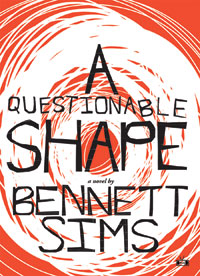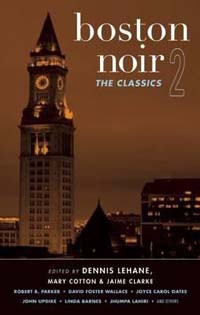A Questionable Shape by Bennett Sims
 A Questionable Shape
A Questionable Shape
by Bennett Sims
Two Dollar Radio, May 2013
242 pages / $16.50 Preorder from Amazon or Two-Dollar Radio
This ain’t your granddaddy’s zombie-apocalypse. Everything in Bennett Sims’s stunning debut courts a topographical and invasive examination of the human condition through our inverse. The architecture of zombie-logic is rewired, and the undead become symbolic for what it means to exist in all its physical and existential, its beauty and brutality.
Post-Katrina. Docile shapes fringe the horizon of greater Baton Rouge. Hurricane season looms yet again, threatening the security of Mississippi barges that quarantine thousands of zombies. If the barges breach, a second epidemic is likely. A Questionable Shape follows Vermaelen over one week as he helps his friend, Matt Mazoch, search for his undead father, retracing “haunts” Mr. Mazoch might return to in his zombified state. But hurricane season is also dwindling the window of opportunity to find him.
Sims escalates the psychological state of the undead, giving them, essentially, purpose. Reanimated, these zombies pursue places from memories. Reanimation, thus, becomes a kind Resuscitation. What the genre formerly defined as a vacant shell of rudimentary desire, Sims infuses with recollection, humanizing the traditionally dehumanized.
“What we know about the undead so far is this: they return to the familiar. They’ll wander to nostalgically charged sites from their former lives, and you can somewhat reliably find an undead in the same places you might have found it beforehand. Its house, its office, the bikelanes circling the lake, the bar. ‘Haunts.’ … In fact, what it calls to mind are those homing pigeons, the ones famous and fascinating for the particles of magnetite in their skulls: bits of mineral sensitive to electromagnetic pulls and capable of directing the pigeons, like the needle of a compass, homeward over vast and alien distances. It is as if the undead are capable of ‘homing’ in this way.”
“…our ‘walking dead’ don’t simply walk: anytime an undead is walking, what it’s really doing is remembering. It’s retracing steps from its former life and moving blindly along a vector of memory. In this way, the tracks that it leaves (of rainwater, of dirt across a carpet, of blood) record more than a physical path: they also materialize a line of thought, the path of that remembering.”
April 15th, 2013 / 12:00 pm
Review of Boston Noir 2: The Classics
 Boston Noir 2: The Classics
Boston Noir 2: The Classics
Edited by Dennis Lehane, Mary Cotton & Jaime Clarke
Akashic Books, 2012
288 pages / Paperback $15.95; Hardcover $24.95
Buy from Akashic Books or Amazon
I dare you to find a better time to revisit noir. Exit-strategying the Middle East, clawing out of near-Depression, facing post-war fears of foreign threats, the parallels to the Fifties bares a bright opportunity to revisit its definitive form of American Escapism. And if there was a book to revisit this escapism, it’s Akashic’s new Boston Noir 2: The Classics.
Since 2004, Akashic has been producing original noir anthologies set in specific cities—Brooklyn, Baghdad, San Francisco, St. Petersburg. Dennis Lehane (Gone, Baby, Gone, Shutter Island, Mystic River) returns to co-edit along with Mary Cotton and Jaime Clarke (Post Road Magazine, No Near Exit) to bring a decadent compilation of stories and novel excerpts that open the noir genre with a rib-spreader and poke it with a knife.
Several books in the long-running series are subtitled: The Classics. Unlike sequels, these books serve as post-prequels, uncovering origins while mapping evolution. The objective is clearly summed up by the editors in the introduction:
“Noir alludes to crime, sure, but it also evokes bleak elements, danger, tragedy, sleaze, all of which is best represented by its root French definition: black.”
January 11th, 2013 / 12:00 pm
